
views
- Play a single note on your harmonica. Use holes 1–6 to bend notes while you draw in or holes 8–10 to bend notes while breathing out.
- Make a “Kk” sound to press the back of your tongue against the roof of your mouth.
- Slide the tip of your tongue back and lower your jaw while you’re playing to bend the harmonica to a lower pitch.
How to Bend Harmonica Notes
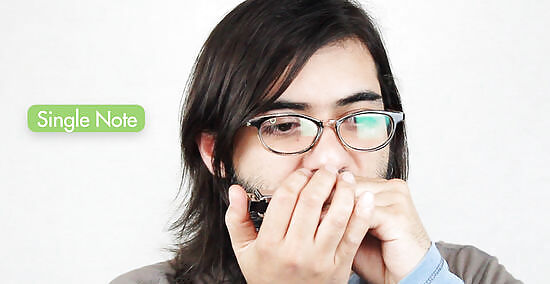
Isolate a single hole to bend on the harmonica. Bending only works when you play into one hole on the harmonica, so practice drawing (breathing in) or blowing until you hear a clean note. Most holes on the harmonica can bend to different notes, but the hole’s position determines if you have to draw (breathe in) or blow to hit the right pitch. Holes 1–6 only bend while you’re drawing. Holes 8–10 can bend when you blow into the harmonica. Hole 7 does not fully bend because there is only a half-step between the blow and draw notes instead of a full step like other holes. Blow bends tend to be a little more difficult because the shorter reeds make the notes harder to control.
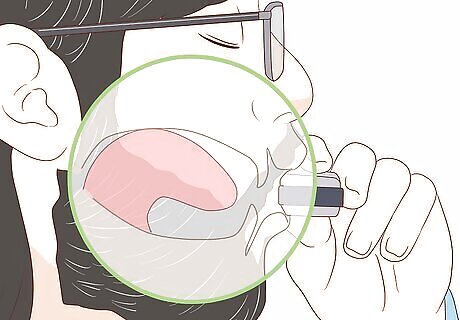
Press the back of your tongue to the roof of your mouth. Make a “Kk” sound and feel where your tongue touches the top of your mouth. Keep holding your tongue in this position and make an “Eee” sound while you’re playing to hit the base note. Your tongue position will be the same whether you’re playing a draw bend or a blow bend.
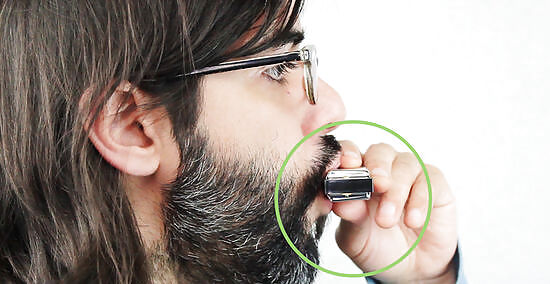
Slide the tip of your tongue back while playing to bend the note. When you’re playing the note, slowly move the tip of your tongue backward and lower your jaw. As your tongue moves back, the space inside your mouth gets larger so you’re able to bend to a lower pitch. To help you reach the right mouth position, keep your lips pursed and try saying “ee-you-yaw” out loud. Notice how your tongue and jaw are positioned at the end, and try to mimic that while you’re playing your harmonica. Try vocalizing the sounds "tee" and "two" by striking your tongue close to your teeth to help the notes sound more punchy. To practice blow bending, try whistling a high note and lowering the pitch to find the right jaw position. If you’re having trouble bending notes, try switching to a different hole on the harmonica to see if you’re able to hit the right pitch any easier.
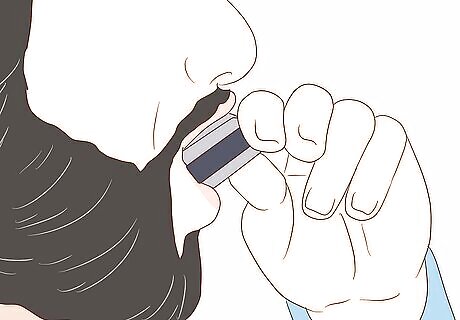
Tilt the harmonica if you have trouble reaching the bent note. If you’re having trouble hitting the bend at first, hold the harmonica so it’s tilted up. When you draw or blow into a hole, the angle will make the reeds inside the harmonica vibrate and play a lower note. Tilting the harmonica is only a temporary solution to help you recognize how a note bend sounds. Once you hear the bend, keep practicing hitting that pitch by changing your tongue and mouth position.
Mastering Harmonica Bending
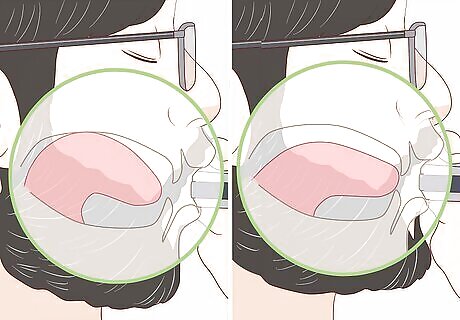
Work on bending and returning to the original note. Start playing a single note on your harmonica, and move your tongue back slowly to lower the pitch. To move back to the original note, slide the tip of your tongue forward and raise your jaw back to its original position. Keep practicing until you’re able to smoothly transition between the notes. It’s okay if the note bend isn’t perfectly in tune right away. As you keep practicing, you’ll develop more control moving between the notes.

Try to maintain the same pitch during the bend. After you hit the lower pitch when you’re bending a note, hold your mouth in the same position and continue drawing or blowing. Use a tuner to check if you’re clearly and consistently maintaining the note bend. If you’re not sure how the note bend is supposed to sound, use the Bend It Better online tool to listen to the notes. You may also record yourself playing and the tool will show you what note you’re hitting.
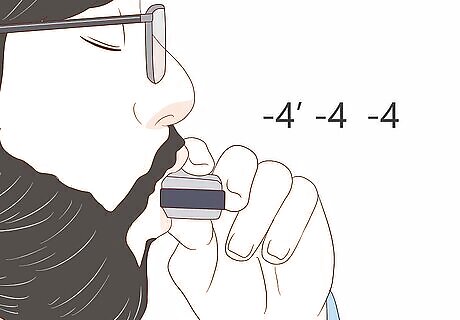
Practice starting on the note bend. Once you get a feel for how to position your tongue and jaw to bend a note, try starting in that position. Do you best to hit the note bend right away instead of the starting note when you draw or blow into your harmonica. When you’re playing a draw bend, imagine that you’re drinking a thick milkshake through a straw to help find the right position for your tongue.
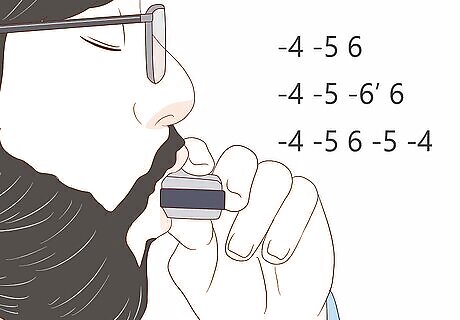
Play along to songs to perfect your bends. As you improve at bending notes on harmonica, follow along with harmonica tabs to some simple songs. Play the hole listed on the tab, and draw in if the note has a minus sign next to it. When a note has an apostrophe next to it on the tab, bend the note to the lower pitch. Some simple songs you can try playing are: “Smoke on the Water” by Deep Purple: -4 -5 6; -4 -5 -6’ 6; -4 -5 6 -5 -4 “Take Me Home Country Roads” by John Denver: 4 -4 5; 5 4 -4’ -4; 5 -4 4; 5 6 -6’ -6 “Long Train Runnin’” by The Doobie Brothers: -4 -4’ -4; -4’ -4; -4’ -4; -4’ -4; -4’ -4 -4; -4 -4’ -3’ -2
Proper Harmonica Technique

Cup the harmonica in both hands. Hold your harmonica so the numbers printed above the holes are on top. Pinch the harmonica between your left thumb and index finger, and rest your middle finger on the back of the instrument. Cup the fingers on your right hand around the back of the harmonica. Try to keep your left thumb and index finger closer to the back of the harmonica so there’s enough space to move your lips and mouth at the front.
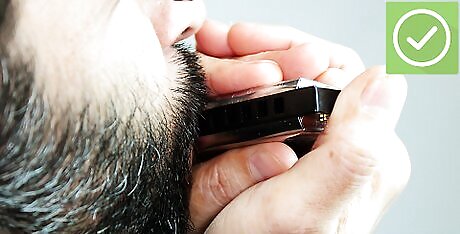
Use a deep, relaxed mouth position to form a seal around your harmonica. For the best control and quality of tone, try to keep your jaw as relaxed as possible while you’re playing. This will create more space in your mouth and give your playing a richer tone. Place the harmonica in your mouth so it contacts the inner part of your lips to give you proper control. Try to avoid puckering your lips when you play a not because it may sound weak or airy.
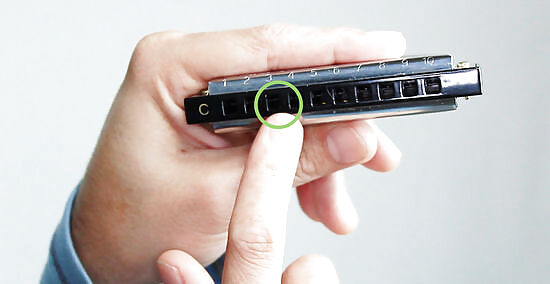
Practice blocking other holes with your lips or tongue. Blocking is a harmonica technique that closes off other holes so you can play a single note you’re trying to bend. You may either block the holes by tightening your lips or making a U-shape with your tongue. Practice both techniques until you’re able to play a single note clearly. To block holes with your lips, narrow the opening of your mouth so it’s about the same width as a pencil. This technique works best for bending notes in blues and melody. To block notes with your tongue, slightly narrow your mouth. Form your tongue into a U-shape so it covers the holes on either side of the one you’re trying to play. Tongue blocking lets you easily switch between playing single notes and a chord.

Use slow and controlled breathing while playing. For the best sound quality when playing, try to avoid puffing on your harmonica. Instead, imagine that you’re breathing through it and try to sustain well-supported breaths. Playing your harmonica with moderate amounts of sustained breathing helps you get a fuller, richer sound than strong blasts of air.
















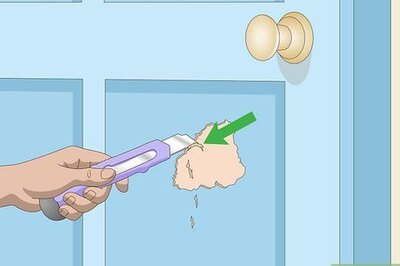

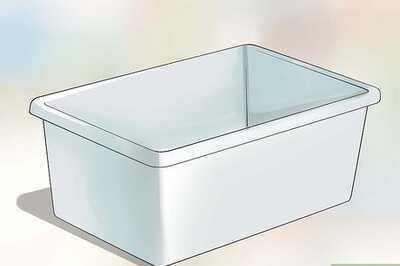
Comments
0 comment